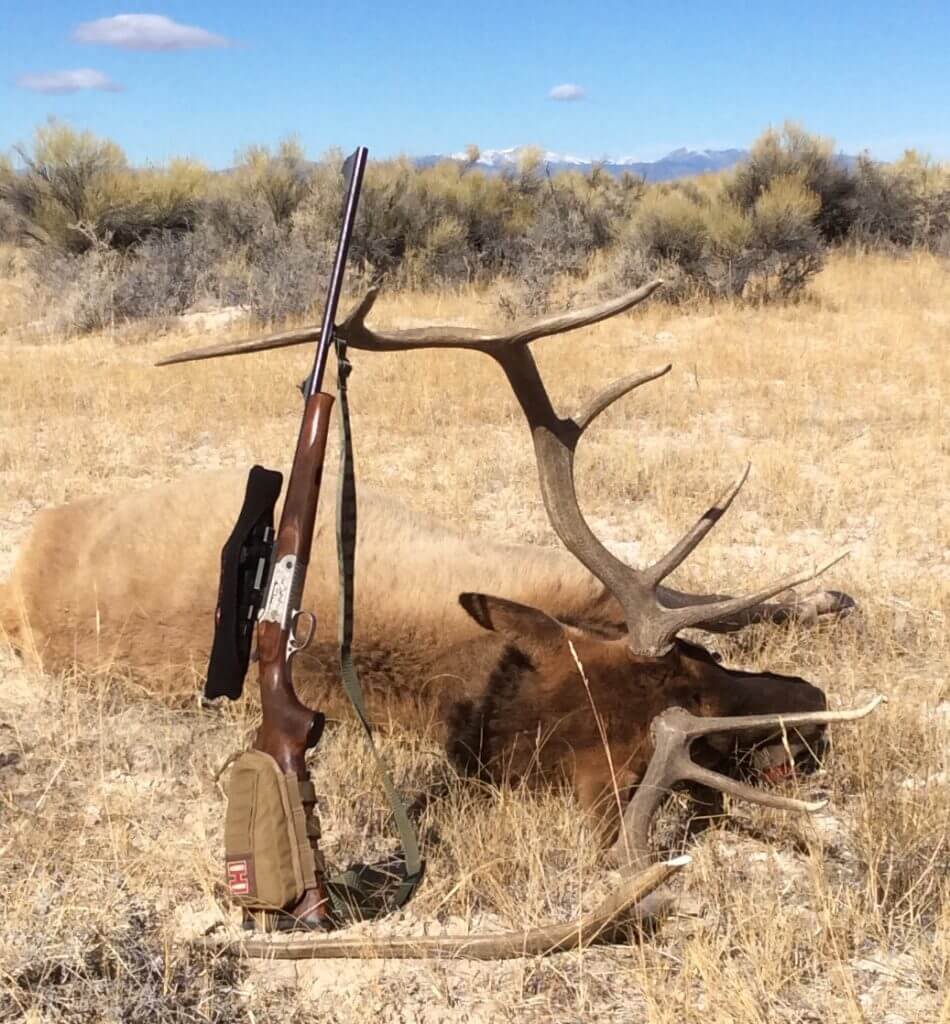
This hunt almost didn’t take place. In June 2019 while I was preparing for the IPSC World Practical Rifle Championship, I injured my knee and had to withdraw from the event.
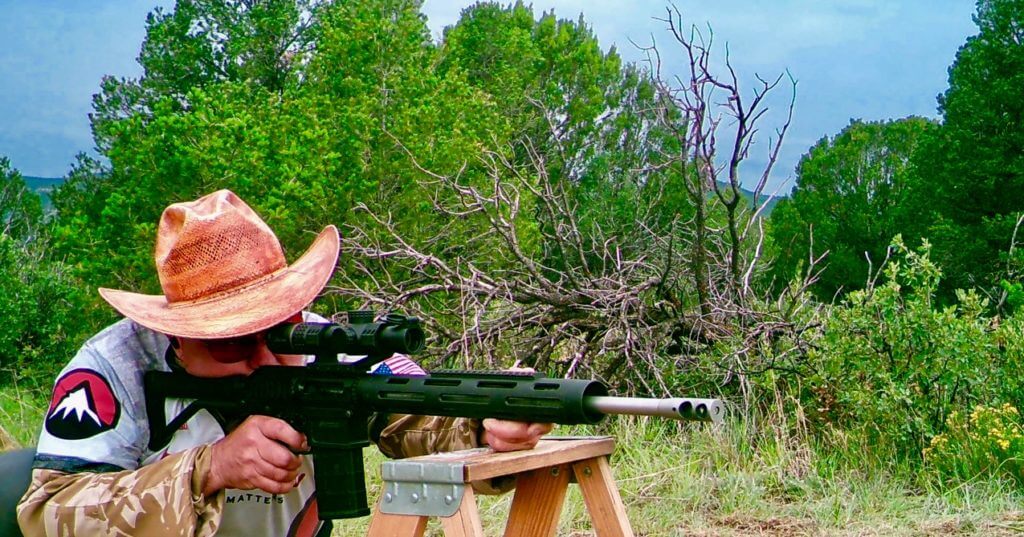
I took the time I had to rest and recuperate so that my planned hunts would not need to be postponed or canceled. I had a Wyoming Hunt for pronghorn and mule deer in early October that would prove to be a good test for my knee and the upcoming Colorado elk hunt. When the time came, the knee was ready for the 12 to 16 miles of walking and biking with a heavy pack.

The hunt was scheduled for the third season and in the previous year, it meant snow and very cold temperatures. This year temps were a bit milder during the day but in the low 20’s at night. The hunt area doesn’t allow any motorized vehicles so you either walk, bike, or horseback it into your area. I utilized a bike to get me in the first 4-5 miles and then walked 4-6 miles hunting followed by biking back out the 4-5 miles. In addition to no motorized vehicles, there are other restrictions limiting you to when you can be in the area and when you must be out, as well as how many helpers you’re allowed to have with you. The area is very much a DIY and muscle power area.
On day 1, I came across a herd of mixed bulls and cows. The herd had 80 to 120 animals, split fairly evenly bulls and cows. There were spikes, raghorns, small 6x6s, and one very nice bull. Sadly, he had broken off his entire left side above his G2, in fact, most of the decent bulls all suffered from broken tines or main beams. I watched them from my hidden vantage point, they were 600 yards from me and moving towards me. I hoped as they got closer that possibly an unseen bull would materialize. I had noticed other hunters around the herd but they appeared further from the herd than me. Suddenly shots rang out and the herd bolted. I counted 12-15 shots and saw no elk go down, the herd turned south and disappeared from my view. I again heard shots from another group of hunters I hadn’t seen but realized they would likely turn the herd back toward me. Sure enough, not ten minutes later the herd came back to me and appeared about 400 yards away. I stood from my gully and stopped their progress, they stalled for a few seconds and then ran back south avoiding the other group of hunters. The day would end with a couple of small groups spotted but no way to close the distance.
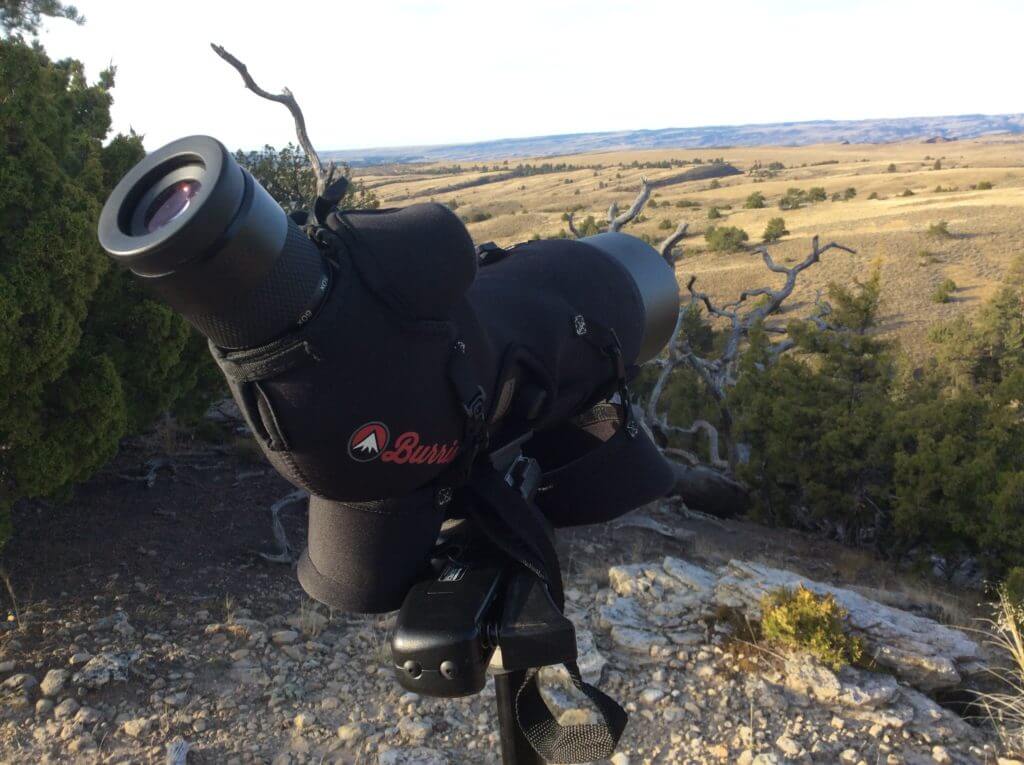
Day 2 would be an easy day of walking due to my lack of conditioning that was required to recuperate my injured knee. I spent the day glassing from high vantage points with my spotting scope and doing very little walking.
I also took the time to reconsider all the gear I had packed on day 1. I removed extra knives, back up clothing, extra food, and water. This lightened my Eberlestock Mainframe pack considerably. Later that day I was lucky enough to meet up with a Wildlife resource officer familiar with the area. He informed me that there were so many cows, that the good bulls were constantly fighting and still fighting even this late in the season. His recommendation was that if I saw a good bull that was mostly intact I should give serious consideration to taking him. Considering what I saw on day one, it sounded like good advice.
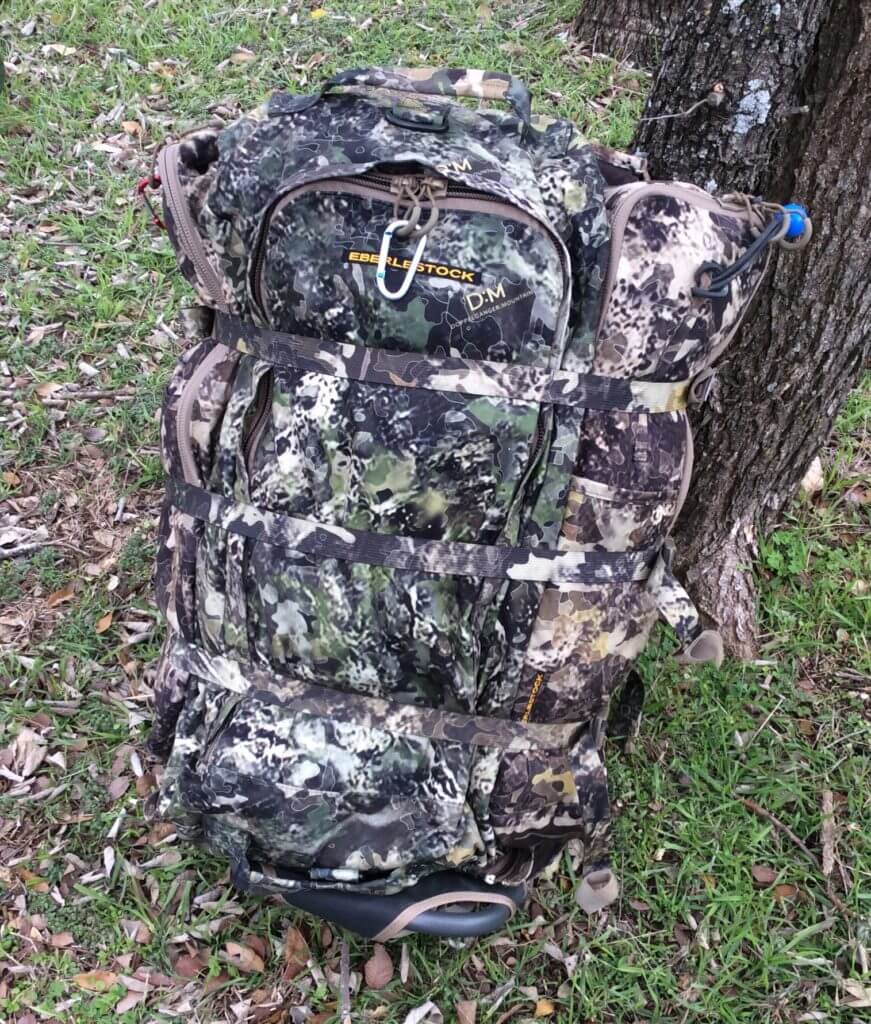
Day 3, started well. When I arrived at my predawn wait and sit location, as the light got better I noticed a moving dark spot, I identified it as a cow elk. I hoped it was the lead cow of a herd but after waiting and having it move off I decided it must have been a lost straggler. I moved north with the wind in my face and had moved about a mile when I saw a small bull behaving very much like the cow from earlier in the morning. I decided to move in that direction hoping that the small bull was looking for its lost herd. As I gained ground on the bull I noticed a dust cloud on the horizon to the east of the bull. I’d seen those dust clouds on day one when the herd was panicked and running. As I strained to determine the source and direction of travel, I decided to drop my pack and take just my rifle, binoculars, small spotting scope, and shooting sticks.

My rifle is a Merkel K3, 30r Blaser, the rifle is a dream to carry and shoots a 165gr. Hornady GMX at 3000fps. The shooting sticks are seven-foot-tall, and of tripod design and have been used to make shots out to 600 yards in long-range competitions. The sticks also work well with the binoculars and spotting scope as an aid to steady movement. Once the pack was dropped and marked so I could return to it. I took off at a quick pace, only stopping occasionally to look for the dust cloud to determine the source and travel direction. I’d covered three to four hundred yards when I realized it was an elk herd and they were moving fast. I picked up my pace and gained another three or four hundred yards in my effort to get in front of them. I realized the herd had stopped and was lingering in some tall sagebrush, tall enough to obstruct an elk body but not good antlers. They had stopped their original line of travel and were now moving south, back the way I had just come. I still had not gotten a good look at the herd but knew there was at least one decent bull that looked completely intact. As in day one, many of the bulls showed evidence of fighting, still, I hoped for at least a chance at the one bull I’d seen that looked intact. I tried quickly pacing it back to my pack, only to have them turn again and head back in the direction they had originally come. I watched as they ran off to the east creating their dust cloud as they ran. I dejectedly walked back to my pack, replaced all my gear, and strapped it back on. I started walking back on my original heading of north. I then heard a high pitched whine that took me by surprise. I turned to the south to see a USAF C17, low in the sky and heading north. I watched as it slowly overtook me and flew by to the east of me.
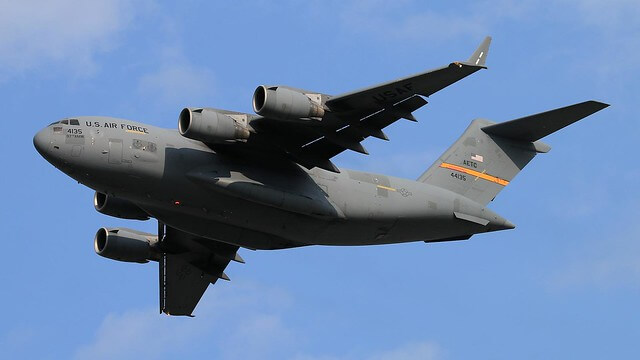
After it passed I noticed the dust cloud from the elk again, they had been turned by the low pass of the plane. This time I was determined to get in front of them and not let this second chance slip away. I just took off at a lope, I was a man on a mission. If I could make it to a lone pinion pine, a half-mile away I could ditch the pack, get my sticks, and pick my elk out. I got to my pinion pine and got ready, they were still 500 to 600 yards out, but had slowed to a walk now and were strung out. This allowed me to see each bull and judge his headgear. I looked over spikes, and raghorns with broken tines, another good bull with only one side intact, and then the bull I’d thought was completely intact. He proved to be mostly intact, his right G3 was gone at the base, and his right G4 was broken about 7 inches up from the base. His left side was undamaged and 6 points, his right was only 5 points with some damage. I decided I wanted him, now I had to find an opening in the tall sagebrush that would allow me a shot into his chest. I scanned forward looking at some of the lead elk and trying to see where I could get a shot.
The sticks were deployed, the rifle supported and my breathing had calmed enough to hold solidly on the moving elk. Once I found my opening, a small one of about 4 feet across, I had to go back and find my elk. He was close to the opening and walking at what I can only assume is a typical elk trot, when he entered the opening I placed the crosshairs about 8” below the top of his back knowing the bullet should drop about 5” at that distance. At the shot, I lost sight of my elk but called the shot good as the crosshairs were on the shoulder when the gun went off and I’d heard the bullet hit.
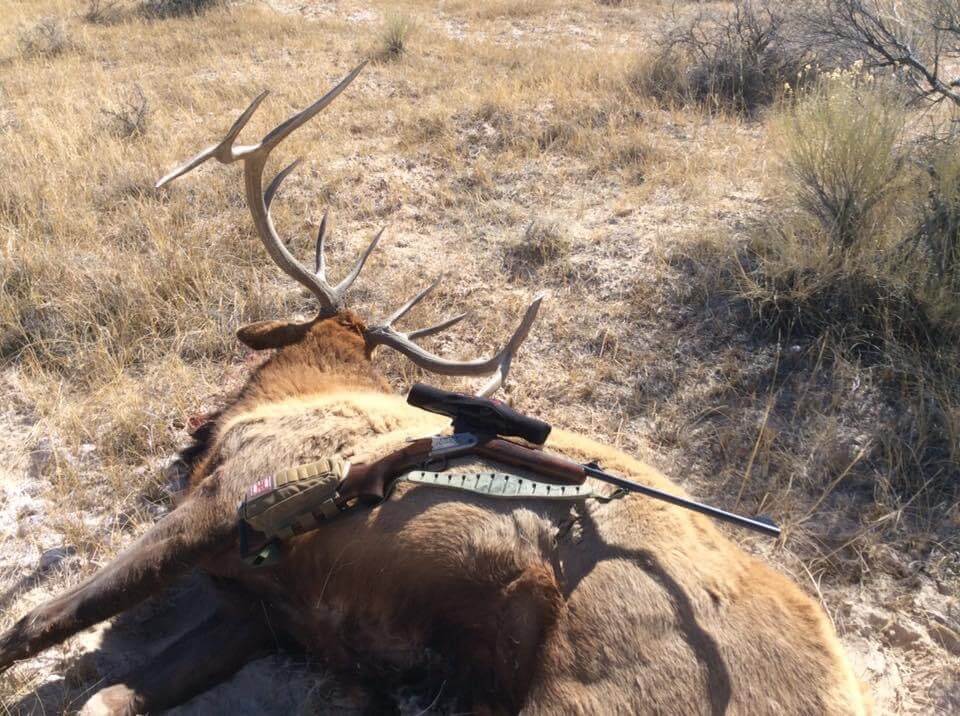
I had to take my eyes off the herd to reload, then quickly scanned the scattered elk for the unmistakeable rack mine carried. They had split into two groups and then rejoined into one, I looked desperately for my bull for a follow-up shot, he wasn’t there. I looked back for the opening I had chosen to shoot into and marked a prominent bush. I had ranged the shot at 327 yards, so knew I needed to cover a bit of prairie. I came to my marked location and there to my right, I saw my bull, my first bull, a DIY solo hunt bull. He had moved approximately 12” from shot to bullet impact and was apparently closer than what I ranged him at. The bullet severed his spine and he dropped, I never saw him drop due to recoil.
Now the work would begin. Did I mention no motorized vehicles allowed? Well, it gets worse, there is a small area inside the hunt area where no mechanical aid is allowed to move your game or hunt from. This is where my elk fell, 2 miles inside that area. So I couldn’t use a game cart or bike to move the carcass or meat. I had underestimated the amount of work it would be for one person to gut and quarter an animal this big. The meat was placed on a tarp and covered and then covered again with sagebrush to keep birds and coyotes at bay. The temps that night got into the low 20’s, so the meat would be okay overnight. That evening I would pack out the backstraps, tenderloins, and some extra meat. My bull was on the ground at 11 am, and I was back at the truck at 9 pm.

That night I was able to enlist the help of a friend who is a wildland firefighter and used to hard strenuous work. We discussed our options and he suggested using plastic snow sleds to drag everything. We came back with the sleds, our bikes, and my game cart.
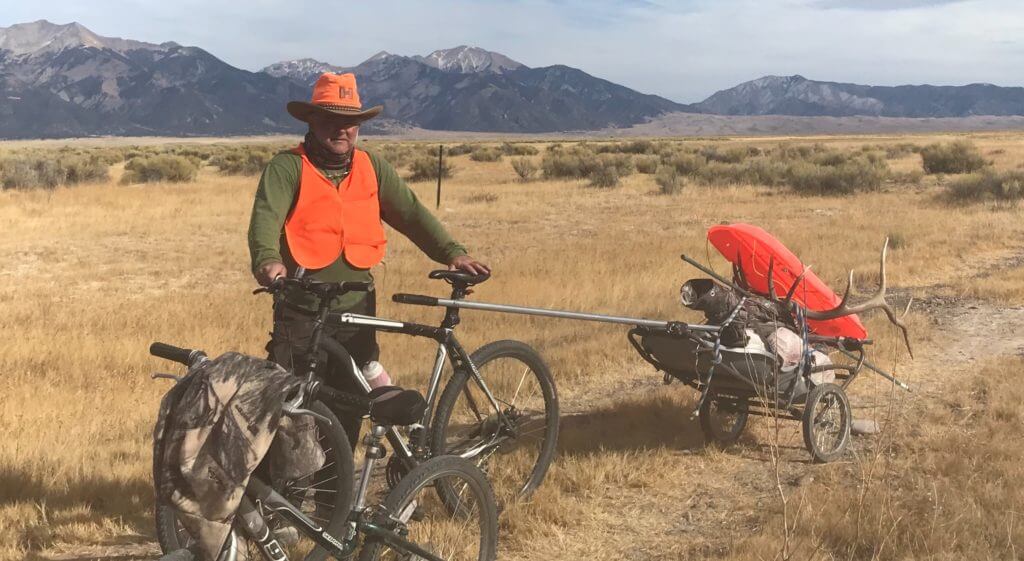
We would ditch the bikes and game cart at the edge of the no mechanized gear area and walk in with the sleds and webbing. We were able to load all the remaining meat, head and antlers onto the sleds and drag them the two miles back to the bikes and game cart in one trip. Our last leg of the trip was 6 miles or so through sage, cactus, and a 1/4 mile stretch of soft sand. Some of it was an old rocky two-track where we could possibly ride our bikes. It was 8 am when we left the truck and almost dark when we returned. We were spent, but both of us happy we were able to accomplish everything in one trip.
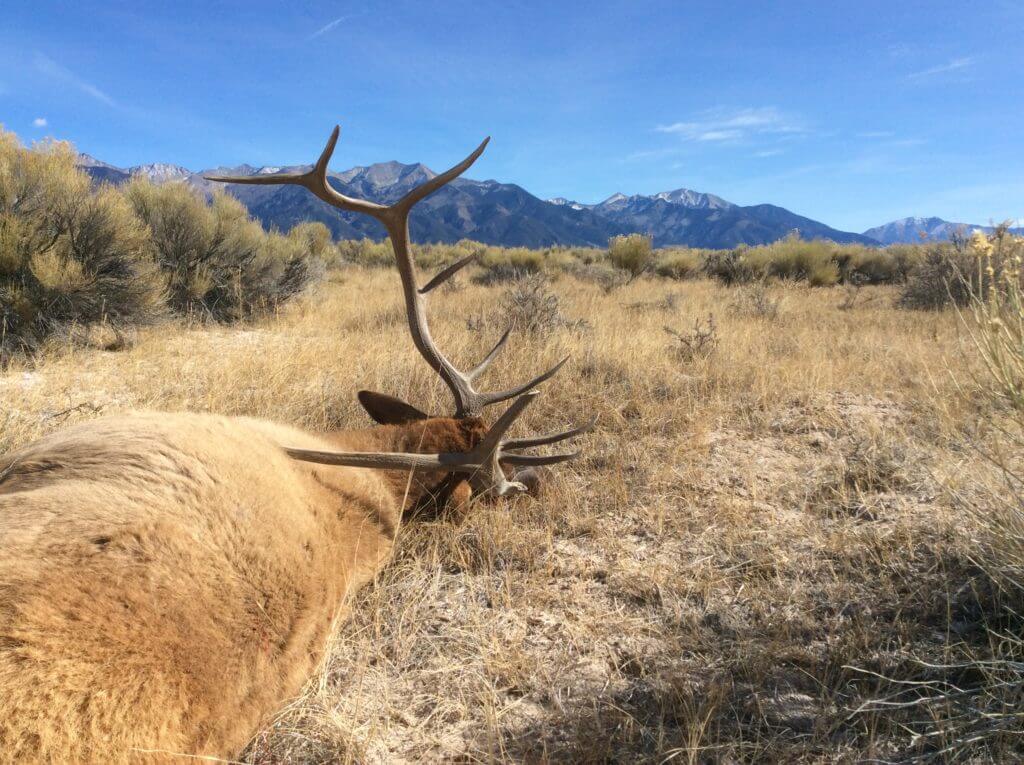
I cannot even begin to explain the value of a good friend… I would buy dinner and drinks the next night, and that still doesn’t cover my debt to him. Thank you, Dale, I owe you big.